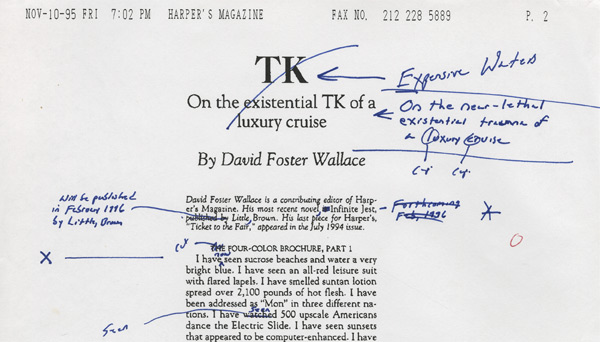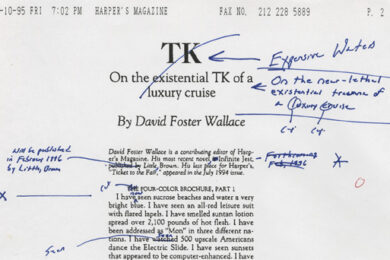These are sentences by David Foster Wallace. Read them and swoon:
“We await, I predict, the hero of non-action, the catatonic hero, carried here and there, across sets by burly extras.”
“He was depressed beyond all human endurance and he stayed that way… he yearned for unconsciousness without end.”
“I wanted to do something sad.”
The first is blisteringly clever – a subtle, almost innocuous little riff that, on closer reading, is rich with echoes from all over the library; a wolf-whistle at some of literature’s slumped and immobile brethren. To Beckett’s Malone, Melville’s Bartleby and to Kafka’s Hunger Artist: they are all potential (if slightly impotent) fathers to the author’s catatonic hero.
The second is unspeakably grim, but not unexpected: despair courses through Wallace’s prose like electricity.
The third? The third is a trick. A remark from an interview made just before the publication of his masterpiece, Infinite Jest, in 1996. Precisely how this claim might wrong-foot the reader is obvious if you’ve read any of his work – precisely because it makes for a fitting description of almost all of his work. The catatonic hero and the depressed person who longs to die are part of a huge cast of deformed, lonely, addicted and unlucky characters that inhabit his writing. The mesmeric voice in all his novels, short stories and essays is intimate with this feeling in all its forms just as a character in Nabokov is alive with butterflies or nymphets.
Wallace’s writing is very funny – sometimes so funny it’s exhausting – and clever in a rare, bewildering way. But, most of all, it’s intensely and immeasurably sad. His life, it seems, was true to form and this is another great and extraordinarily sad book; a history of anxiety and depression, anguish and finally, death. D.T. Max’s biography Every Love Story Is A Ghost Story is the bleakest sort of ghost story, one haunted by the suicide of its subject, who hanged himself in 2008.
Max traces this brilliant and difficult life with great elegance and lucidity, carefully charting Wallace’s development from an especially phobic little boy – anxiously gathering facts about dangerous insects and shark attacks – to a jittery, stoned teenager and finally, a “psychotically depressed” young man, routinely ravaged by what his mother called “the black hole with teeth”. Inside his head was a frightening place; a jagged labyrinth where branches of panicked thinking spiraled out unceasingly. Yet, despite such enticing material, Max smartly resists the skewed telepathy-effect that plagues so many biographies, remaining empathetic without suggesting an unequalled insight into his subject’s thoughts – thoughts that were, after all, frequently unfathomable to Wallace himself. What Max makes quickly obvious, though, is that his subject was both “very, very smart” and also “obscurely defective” (both self-diagnoses); nervous and withdrawn, shadowed by a history of suicide in his mother’s family, Wallace’s life was a constant and strained juxtaposition.
Max provides a fine portrait of the artist as a slightly younger man (Wallace was only forty six when he killed himself): he was an almost unnervingly brilliant student whose academic career was a procession of A-plusses, dumbstruck teachers and awed acquaintances. He wrote his strange and sprawling first novel The Broom Of The System whilst still at university, in a state of rapture and greed, often stopping to be sick with over-excitement, watched over by the famous snapshot of Thomas Pynchon he kept tacked on his bedroom wall in place of a religious idol.
The novel was published when the numb fatalism of Raymond Carver was both adored and badly imitated throughout American fiction. Its “telegraphed misery” (Max is always incisive) was everywhere, and Wallace, with his intricately choreographed sentences and Catherine-wheel exuberance suffered incomprehension and indifference. The long process of what he called his “fucking up” and a friend – noting a certain saintly arc to the story – termed his ‘process of purification,’ began. Inner-city Boston and environs, later the setting for Infinite Jest, doubled as his purgatory where he lived in limbo between suicide and studying philosophy at Harvard, writing and addiction, none of them particularly alluring.
Following this immense talent as it races toward oblivion is darkly fascinating – it’s also very painful. Wallace’s life became a nightmarish carnival of intoxication and angst. He almost choked to death on his own vomit after drinking too much at the auspicious writer’s retreat Yaddo: ‘Aesthete’s aspirations aspirated!’ he wrote sardonically to a girlfriend. Beneath this black humour there lies a spectral figure, a spooked recluse nightly drinking and drugging himself into unconsciousness, watching an obscene amount of TV and writing almost nothing. His season in hell lasted nearly three years and left him, as one lover recalls (and there are plenty – Wallace had a chronic case of satyriasis, too), ‘a shocking wreck’. More than once, he is likened to Dostoyevsky’s Underground Man, similarly manic, paranoid and hopelessly poor. Writing, too, seems to have been an addiction for Wallace, just as – or perhaps more – intensely than television, alcohol and cannabis: he was capable of writing twenty-five thousand words in a day, and ditching all of it. Stories were written quickly in secret binges where he was completely intoxicated by the pleasures of his invention. Writing paraphernalia was fetishised – pens, which had sired good work, were nicknamed “orgasm pens.” Without a project, Wallace felt bereft and rudderless. And it was the torture of writing, rather than any other intoxicant, which would lead to his death.
It is in this terrible gap – between the end of his early, playful writing and the beginning of his intense, mature work, inaugurated by Infinite Jest – that this biography supplies its greatest riches; this is where we are most sharply able to see, just as Max hopes, “a remarkable being in the process of becoming,” as he maps out in detail a period that Wallace understandably spoke of obliquely or not at all. He clawed his way towards his sobriety but remained “blank, depressed and befogged” when contemplating his work. Slowly, painfully, the great writer appears on the page. Disenchanted with the perceived knowingness and nihilism of postmodern fiction, he started tracing out a different kind of work. The cerebral mischief and corrosive irony he’d supplied before needed to be replaced: they were simply two more kinds of newly forbidden narcotic. The delirious texture of his prose survived, traumatised, coupled with that unmistakable note of sadness. He wanted the reader to feel “less alone inside.” Emotion and illumination were newly permitted: he would aim to make “the head throb heartlike.”
Infinite Jest began to take shape, transforming from a forest of dense, disordered text vaguely strung together to a totemic and enormous novel – an opulent and tragic evocation of a particularly modern and peculiarly American “lostness.” Between grief and nothing, its characters will take nothing; so acute is their wish to disappear. Depression and addiction are part of the weather. A “black hole with teeth” seems to live inside everyone.
When the book was released, Wallace was thrown back into the kind of temptation he had fought to resist. Momentarily, a hyped “literary it-boy,” receiving all sorts of adulation, he remained hopelessly “marooned inside his own skull” (one of his best, bleakest metaphors). He called upon Don DeLillo as a sort of Virgil to guide him through the Inferno of writerly fame and doubt. The generous volume of quotations from their correspondence is one of the major treasures here – one letter finds Wallace describing all the ‘fuss’ around his novel, unfurling a sentence that could come straight from his fiction. Bristling and bewildered, he writes, “Everyone’s tremendously excited over the tremendous excitement surrounding a book that takes over a month of hard labour to read.” In the wake of Infinite Jest‘s success, he worries all his achievements have been “a fluke” and he has “nothing lapidary inside” anymore. The older writer reminded him that “confusion, indecision [and] considerable doubt” were inescapable parts of the art.
Things slowed down. Wallace’s vertiginous terror about being alive wore off and his demons weren’t exactly exorcised but calmed. Ordinarily, a biography settles into cosy torpor after this, a gentle rhythm of success, writing, further success, and decline. And this is almost what happens: Max captures how a “generation of readers read their lives” in Wallace. Two more collections of stories were published, Brief Interviews With Hideous Men and Oblivion, more severe than his past work, he married and reached something close to stability. But another nightmare slowly took shape in the background.
Wallace struggled for eleven years, black hole always chewing, working on “the long thing,” his third novel, which would become the posthumously published The Pale King. All the “doubt, confusion and indecision” induced by writing became unbearable. He could never find a way to make its hundreds of disparate fragments cohere; any centre remained permanently elusive. Everything began to fall apart again. Like one of the addicts in Infinite Jest he found himself paralysed before something “too large to be seen in totality,” equally consumed by “total psychic horror… decay, death, dissolution.”
He attempted to free himself from anti-depressants, hoping this might remove whatever was obscuring the work, but “the old terror” was still there. His condition worsened. Other medications failed, and he was unresponsive to the electro-convulsive therapy he’d dreaded since he was a young man. Left so hollow by the procedures he was unable to even read, he began to long for “unconsciousness without end” again. There is no surprise ending here – that was what he found, and that is the ghost story D.T. Max tells.



